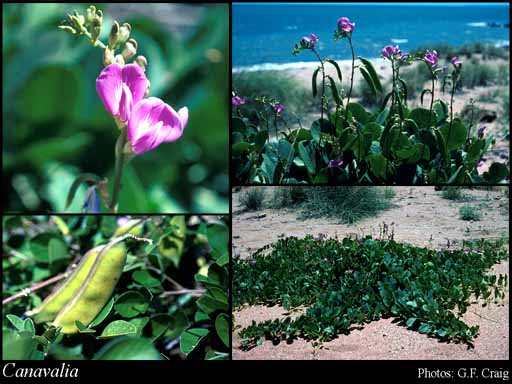- Reference
- Fam.Pl. 2:325 (1763)
- Name Status
- Current

Scientific Description
Family Papilionaceae. Phaseoleae.
Sometimes included in Leguminosae.
Habit and leaf form. Shrubs, or lianas; evergreen, or deciduous; resinous, or not resinous. Self supporting, or climbing (or trailing); the climbers stem twiners. The twiners twining anticlockwise. Helophytic, or mesophytic, or xerophytic. Leaves medium-sized; alternate; spiral, or distichous; ‘herbaceous’, or leathery; not imbricate; petiolate. Petioles wingless. Leaves non-sheathing; not gland-dotted; compound; pulvinate; ternate. Leaves pinnately trifoliolate. Leaves imparipinnate. Leaflets 3; 4–15 cm long. Lateral leaflets opposite. Leaflets minutely stipellate. Leaflets without swollen, glandlike stipels. Leaflets pulvinate; elliptic, or ovate; cuneate at the base, or rounded at the base; flat; without lateral lobes. Leaflet margins flat. Leaf blades dorsiventral; cross-venulate. Leaves with stipules. Stipules intrapetiolar; free of one another; scaly, or leafy; caducous. Leaf blade margins entire; not prickly; flat. Leaves without a persistent basal meristem. Leaf anatomy. Complex hairs absent. Branched hairs absent. Stem anatomy. Secondary thickening developing from a conventional cambial ring, or anomalous.
Reproductive type, pollination. Fertile flowers hermaphrodite. Unisexual flowers absent. Plants hermaphrodite. Floral nectaries present. Nectar secretion from the disk. Entomophilous; via hymenoptera.
Inflorescence and flower features. Flowers aggregated in ‘inflorescences’; not crowded at the stem bases; in racemes and in fascicles. Inflorescences compound (pseudoracemes); axillary; axillary pseudoracemes, the swollen nodes each with fascicles of 2–6 pedicellate flowers. Flowers pedicellate; bracteate; (bi-) bracteolate. Bracteoles deciduous (small, caducous). Flowers small to medium-sized; very irregular; zygomorphic. The floral asymmetry involving the perianth and involving the androecium. Flowers papilionaceous (imbricate-descending); basically 5 merous; tetracyclic. Floral receptacle developing a gynophore, or with neither androphore nor gynophore (the ovary (sub)stipitate). Free hypanthium present, or absent. Hypogynous disk present; intrastaminal. Perianth with distinct calyx and corolla; 10; 2 -whorled; isomerous. Calyx present; 5; 1 -whorled; gamosepalous; lobed; blunt-lobed and toothed. Calyx lobes markedly shorter than the tube to about the same length as the tube. Calyx erect; imbricate; exceeded by the corolla; bilabiate (the upper lip with two larger, semicircular and partly connate lobes, the lower with three small, triangular lobes); neither appendaged nor spurred; non-fleshy; persistent; non-accrescent; with the median member anterior. Corolla present; 5; 1 -whorled; appendiculate (the standard). Standard appendaged (auriculate, with two small calli at the base). Corolla polypetalous, or partially gamopetalous. 2 of the petals joined (the two anterior petals connivent to form the ‘keel’ of the typical ‘papilionate’ corolla), or 4 of the petals joined. The joined petals of the papilionate corolla anterior (or anterior and lateral). The wings of the corolla free from the keel; not laterally spurred. Standard ‘normally’ developed; not sericeous. Keel conspicuously exceeded by the wings, or about equalling the wings; not long-acuminate/beaked; neither coiled nor spiralled; not bent and beaked. Corolla imbricate (descending); glabrous abaxially; glabrous adaxially; pink, or purple (or mauve); deciduous; non-accrescent. Petals clawed, or sessile. Androecial members definite in number. Androecium 10. Androecial sequence not determinable. Androecial members free of the perianth; markedly unequal (alternately long and short); coherent (at least above); 1 - adelphous (in a closed tube), or 2 - adelphous (then the tenth, posterior stamen free of the tube at the base); 1 -whorled. Androecium exclusively of fertile stamens. Stamens 10; all more or less similar in shape; diplostemonous; both opposite and alternating with the corolla members; filantherous. Anthers connivent; all alike; dorsifixed; versatile; dehiscing via longitudinal slits; latrorse, or introrse; tetrasporangiate. Pollen shed as single grains. Gynoecium 1 carpelled. The pistil 1 celled. Carpels reduced in number relative to the perianth. Gynoecium monomerous; of one carpel; superior. Carpel stylate; apically stigmatic. Style (in-) curved. Style hairy but not bearded, or glabrous. Stigmatic tissue terminal. Carpel 2–15 ovuled (‘several’, or ‘fewer than 10’). Placentation marginal (along the ventral suture). Gynoecium median (the placenta posterior, on the ventral suture). Ovary subsessile. Ovules pendulous to ascending; biseriate; arillate; anatropous, or campylotropous to amphitropous, or hemianatropous.
Fruit and seed features. Fruit aerial; 70–220 mm long; stipitate; non-fleshy; not spinose. The fruiting carpel dehiscent; a legume. Pods much elongated; not triangular; straight, or curved; not beaked; not becoming inflated; somewhat compressed; irregularly constricted, or not constricted between the seeds; transversely septate between the seeds (with membranos tissue); wingless; not internally hairy. Valves of the dehisced pod not twisted. Fruit 1 celled; elastically dehiscent, or passively dehiscent. Dispersal unit the seed. Fruit 4–15 seeded. Seeds non-endospermic; not mucous; somewhat compressed; medium sized; arillate, or non-arillate (the Australian floras inconsistent on this); not conspicuously hairy; wingless. Cotyledons 2; accumbent. Embryo curved, or bent. Testa non-operculate; smooth. Micropyle zigzag, or not zigzag. Seedling. Germination phanerocotylar.
Special features. Upper lip of calyx lobed; 2 lobed. Lower lip of calyx lobed; 3 lobed.
Geography, cytology, number of species. Native of Australia and adventive. Endemic to Australia and not endemic to Australia. Australian states and territories: Western Australia, South Australia, Northern Territory, Queensland, and New South Wales. X=11, 2n=22; ploidy levels recorded 2 (2n=22). A genus of about 50 species; 3 species in Western Australia; 0 endemic to Western Australia.